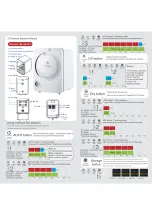
RTC
®
5 PC Interface Board
Rev. 1.9 e
8 Advanced Functions for Scan Head and Laser Control
159
innovators for industry
During initialization of the RTC
®
5 (via
), the internal jump delay table is
initialized with a squareroot curve and with a jump
delay end value of 1024 (i.e. 10.24 ms) for a jump
length of 2
20
bits.
Automatic Determination of the Jump Delay
Table
You can initiate automatic determination of the jump
delay table via
(parameter
Name
= 0) if you had previously enabled and acti-
vated jump mode successfully via
(
Flag
= 1).
For automatic determination, automatic laser control
will be deactivated if necessary, the data type
returned by the scan system will be set to target
position and the tuning set to the jump tuning that
had been defined via
(the original
settings will, if necessary, be restored when the
command completes).
For automatic determination, several diagonal jumps
of varying lengths will be performed. For each jump,
the target position returned by the scan system will
be recorded via
and
. The data is analyzed for
the timepoint at which the specified position
tolerance (
PosAck
parameter) was last exceeded, i.e.
when the target position persistently remained in the
jump target positional range ±
PosAck
. This value will
then be reserved as the jump delay value associated
with the corresponding jump length.
Notes
• Before automatic determination, you must
absolutely switch off the laser.
• Data recording requires execution of a list with a
total of six commands. The commands will be
automatically written to list memory and
processed. The parameter
ListPos
indicates the
position in list memory (“list 1” or “list 2”) in
which storage is to occur. This position should be
such that any previously entered list commands
can be harmlessly overwritten.
• For automatic determination, the longest jump is
performed first, followed by increasingly shorter
jumps (with a maximum of up to 16 different
jump lengths). For the first (longest) jump length
(jump across the entire image diagonal), the
measurement period is specified via the
parameter
MaxDelay
[10
µ
s]. For subsequent
(shorter) jumps, it is defined by each previously
determined jump delay.
MaxDelay
should be
chosen to be adequate but not significantly larger
than the jump delay for the longest jump. A
larger
MaxDelay
increases the total required
execution time. With
MaxDelay
= 500, the total
execution time for automatic determination will
typically be a few seconds.
• For statistical noise reduction, four identical
jumps will be performed for each jump length
and the results averaged. Additionally, the values
for each individual measurement will be low-pass
filtered (2-point smoothing). This permits
selection of a position tolerance
PosAck
that can
also be somewhat (but not substantially) under
the expected noise level (but note that XY2-100
converters only return whole multiples of 16.
Here, a noise level of ±3·16 bits can be expected).
• If the
PosAck
range is not persistently reached
within the measurement period, then
MaxDelay
becomes the determined jump delay.
• If the determined jump delay is smaller than
MinDelay
, then
MinDelay
becomes the deter-
mined jump delay and the measurement will
terminate. Then, shorter jumps will no longer be
performed and
MinDelay
will also be the deter-
mined jump delay for these shorter jump lengths.
A longer
MinDelay
reduces the total execution
time for automatic determination.
• If an offset is specified for automatic determi-
nation (via the according
parameter), this offset
will be added to all automatically determined
delay values before the overall jump delay table
gets calculated via linear interpolation and
loaded onto the board (in addition, the delay
values will be clipped to the value range
0…65535).
The Offset can be used to compensate for
measurement runtime latencies (e.g. caused by
an XY2-100 converter, by tuning switching or by
a runtime latency of the returned signal) when
calculating the jump delay table. It can also be
used to add a safety margin to the delay values to
compensate for noise-induced random devia-
tions.
The
command is identical to
with
Offset
= 0.
• For simultaneous control of two scan systems,
you should determine the jump delay values for
both systems and, after comparing, use the
values of the slower system.
















































